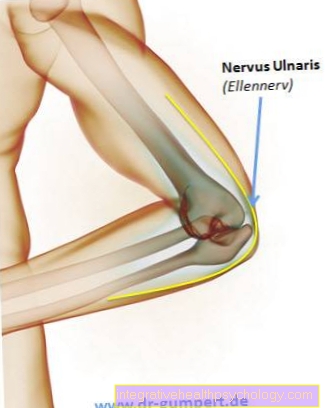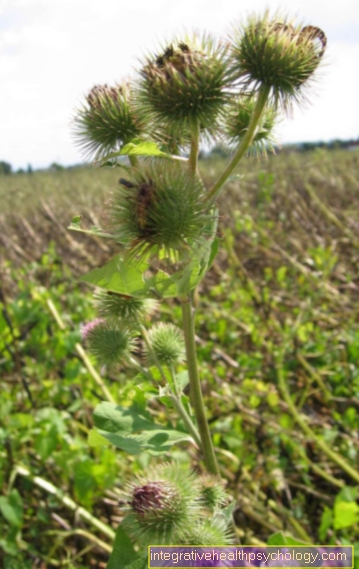Laryngeal mask
What is laryngeal mask anesthesia?
Laryngeal mask anesthesia is a normal general anesthetic in which endotracheal intubation is dispensed with and a laryngeal mask or larynx mask is used instead. Unlike a tube, which is often used to secure the airways during anesthesia, the so-called laryngeal mask is not inserted behind the vocal cords into the windpipe, but remains in the throat in front of the larynx, where it is inflated and ensures ventilation.
This article might also interest you: Types of anesthesia - which are there?

indication
In most cases, the laryngeal mask offers an alternative to classic endotracheal intubation to secure ventilation during general anesthesia. However, there are also a number of contraindications that prohibit the use of the laryngeal mask. In all operations on the face, mouth and ear, nose and throat area, the airway must be secured by endotracheal intubation, since a laryngeal mask can easily slip due to its proximity to the operation area when moving and pulling in the throat and thus endangers ventilation.
Find out more about the topic: Mask anesthesia
The laryngeal mask cannot be used on patients who have not fasted or are pregnant. In this group of patients there is always the risk of stomach contents flowing back into the esophagus and thus also the risk of being carried over into the trachea. Since the laryngeal mask, unlike the tube, does not reliably seal the trachea, it is clearly contraindicated here. For the same reason, endotracheal intubation is also indicated in patients suffering from heartburn or frequent belching. The laryngeal mask is also not suitable for complex operations lasting several hours; here the tube also offers more safety for complication-free ventilation. The laryngeal mask is a gentle and safe alternative to endotracheal intubation for short operations in patients without previous illnesses in the stomach or in the pharynx and throat area.
Read more on the topic: Intubation anesthesia
Advantages of a laryngeal mask
Ventilation with a laryngeal mask offers many advantages during anesthesia. On the one hand, the mask is easier to insert compared to the tube, and there is no need for any additional aids to insert the mask like the laryngoscope with the tube. This always brings with it the risk of injuries in the surrounding tissue. Muscle-relaxing medication can often be dispensed with during anesthesia with a laryngeal mask and generally fewer anesthetics are used. This greatly shortens the waking up phase after the operation and is often described by patients as a gentle wake-up.
Another advantage of the laryngeal mask during the wake-up phase after anesthesia is the reduced irritation of the airways. Patients are less likely to have the urge to cough when they wake up and begin to breathe spontaneously again in a more relaxed manner. Many patients also find the laryngeal mask more comfortable than a tube, since the vocal folds do not have to be passed and therefore there is no irritation here. Therefore sore throats occur much less frequently after laryngeal mask anesthesia and hoarseness almost never.
Find out more about the topic at: Intubation
Disadvantages of the laryngeal mask
The biggest problem with anesthesia with a laryngeal mask is that ventilation with a laryngeal mask is not a safe airway. This means that the mask can slip easily despite optimal positioning and blocking of the cuff and endangers the oxygen supply. There is a risk of slipping particularly in operations in which the patient has to be moved or repositioned during the operation. In most cases, the mask can be corrected by slight measures, but this must be done during the operation under difficult conditions and in rare cases is no longer possible.
Should this occur, emergency endotracheal intubation is required, which is associated with an increased risk under difficult conditions. The laryngeal mask also offers no protection against aspiration. So if stomach contents or stomach acid flow back into the throat area, it can pass through the laryngeal mask and enter the lungs via the windpipe. This can result in life-threatening pneumonia and damage.
Risks / complications of the laryngeal mask
Compared to endotracheal intubation, anesthesia with a laryngeal mask is associated with some risks. Since the laryngeal mask is located in front of the larynx and not in the windpipe behind the vocal folds, there is always a risk of slipping. Often there is only a slight change in the situation, which only creates a leak in the oxygen supply. However, this leak can usually be closed again easily with minimal corrections to the mask. However, if the mask is completely displaced or, in the worst case, if the mask is pulled out, emergency intubation using an endotracheal tube is usually necessary.
Moving the mask can lead to severe injuries and swelling in the throat, which can ultimately result in life-threatening air tightness. Another serious complication of laryngeal mask anesthesia is aspiration. If stomach acid refluxes into the esophagus, it can flow past the laryngeal mask and enter the trachea and then into the lungs. In the lungs, stomach acid can cause serious damage and life-threatening pneumonia.
You might also be interested in this topic: Risks of anesthesia
What are contraindications / signs for a laryngeal mask?
The contraindications for the use of laryngeal masks result from the risks and complications. A laryngeal mask should be avoided in all operations in which repositioning or frequent movement of the patient is foreseeable. Endotracheal intubation is standard here and is used to secure ventilation. Operations that take a long time or that involve working with strong pressure changes in the body, for example laperoscopy (laparoscopy), are contraindications for the laryngeal mask.
In addition to the circumstances of the operation, patients can also give cause for the contraindication of a laryngeal mask. Due to the risk of aspiration, laryngeal masks must not be used in any patient with a known reflux disease or a tendency to frequent belching. Diseases and infections in the throat and larynx also prohibit a laryngeal mask. Another contraindication for the use of laryngeal masks is an existing pregnancy or severe obesity. There is also a risk of aspiration here, as the high body weight exerts great pressure on the stomach in a lying position and possibly causes gastric acid to flow back into the esophagus.
Sore throat after a laryngeal mask
Although the laryngeal mask is much gentler than the tube, in some cases there is still a sore throat after the operation. These sore throats are usually caused by irritation of the mucous membranes in the throat and larynx area caused by inserting and removing the mask. In most cases, the sore throat only lasts for a short time and does not require any further therapy. However, if breathing problems and shortness of breath also occur, a medical check-up must be carried out immediately in order to rule out life-threatening swelling and injuries.

















.jpg)











